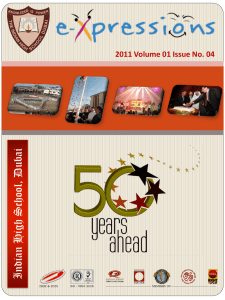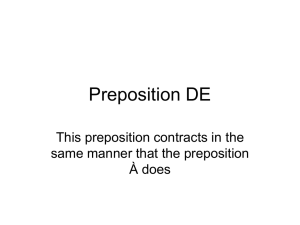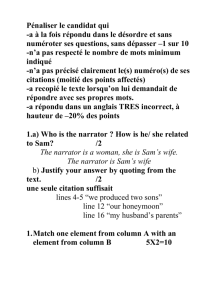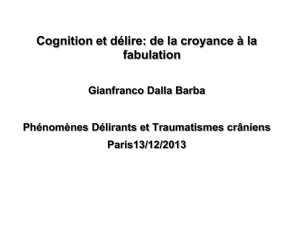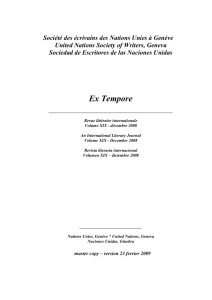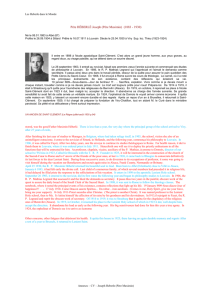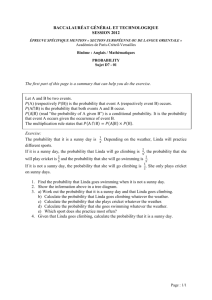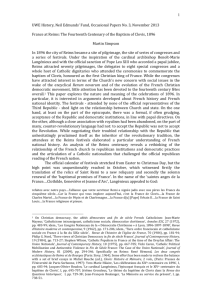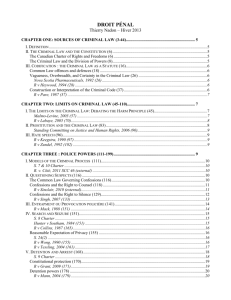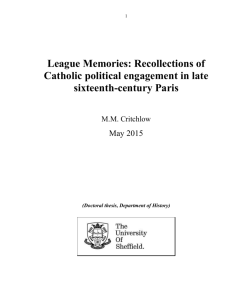Applications
advertisement
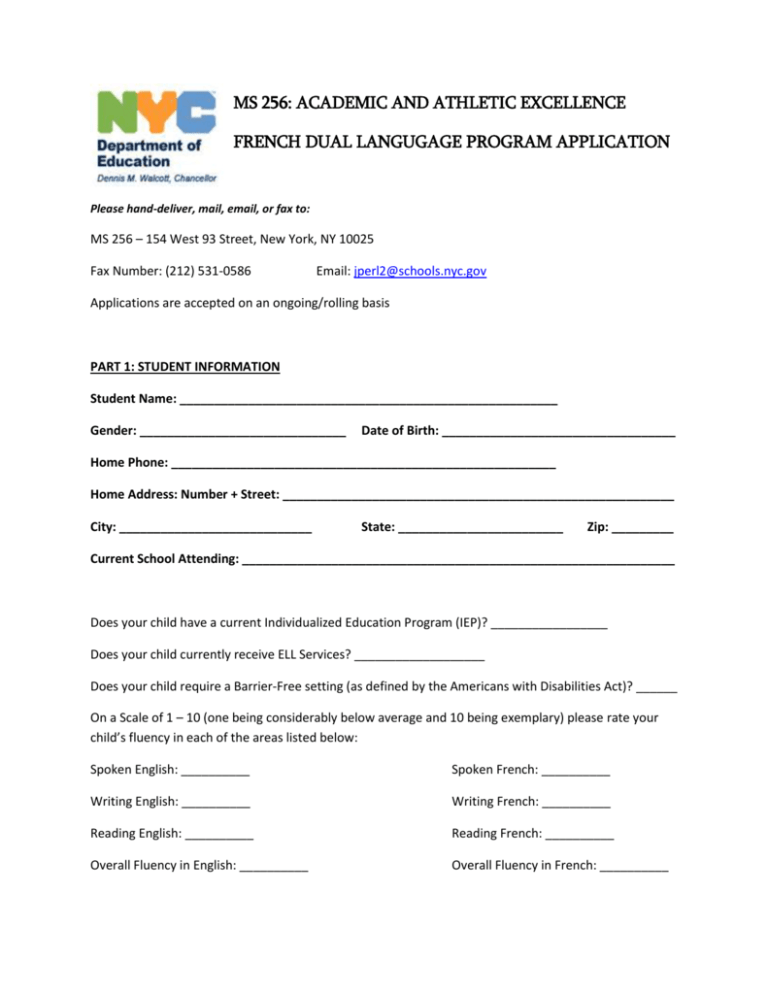
MS 256: ACADEMIC AND ATHLETIC EXCELLENCE FRENCH DUAL LANGUGAGE PROGRAM APPLICATION Please hand-deliver, mail, email, or fax to: MS 256 – 154 West 93 Street, New York, NY 10025 Fax Number: (212) 531-0586 Email: jperl2@schools.nyc.gov Applications are accepted on an ongoing/rolling basis PART 1: STUDENT INFORMATION Student Name: _______________________________________________________ Gender: ______________________________ Date of Birth: __________________________________ Home Phone: ________________________________________________________ Home Address: Number + Street: _________________________________________________________ City: ____________________________ State: ________________________ Zip: _________ Current School Attending: _______________________________________________________________ Does your child have a current Individualized Education Program (IEP)? _________________ Does your child currently receive ELL Services? ___________________ Does your child require a Barrier-Free setting (as defined by the Americans with Disabilities Act)? ______ On a Scale of 1 – 10 (one being considerably below average and 10 being exemplary) please rate your child’s fluency in each of the areas listed below: Spoken English: __________ Spoken French: __________ Writing English: __________ Writing French: __________ Reading English: __________ Reading French: __________ Overall Fluency in English: __________ Overall Fluency in French: __________ PART 2: PARENT/GUARDIAN INFORMATION I certify that all of the above information is true and correct. I understand that giving false information will invalidate this application. Parent(s)/Guardian(s) Name: _____________________________________________________________ Daytime Phone Number: ______________________________ Mobile/Cell Phone Number: ____________________________ Email Address: _______________________________________ Parent Signature: ____________________________________ Date: ______________________________________________ (Application is incomplete without parent signature). Note: This application has 9 pages. All 9 pages must be completed to process the application. Upon receipt of a completed application, a representative from MS 256 will contact you to schedule an interview day and time for your child. PART 3: STUDENT WRITING SAMPLES Please respond to the following prompts in the languages requested. (If you are completing the application electronically, you may write in the space directly below the prompt. If you are printing and mailing, faxing, or hand delivering the application, please attach your responses on additional pages – responses may be typed or hand-written). If you do not feel comfortable, or are unable to complete a response in the language requested, please indicate (in your native language) that you will not complete the section. No student will be penalized or denied entrance to the program based upon his or her inability to complete a writing sample. English Writing Prompt: Why do you want to attend a Dual Language Program? Why is being bilingual important to you? French Writing Prompt: Racontez une histoire d’un voyage que vous avez fait, en faisant ressortir l’aspect drôle ou sévère de l’histoire. Où êtes-vous allé(e) ? Qu’avez-vous fait ? Pourquoi le voyage était-il important pour vous ? PART 4: STUDENT READING SAMPLES Please read each of the passages below and answer the questions that follow. Cousin Maurice by Nan Meyers Janine was upset when she heard the news. “Your cousin Maurice is coming to Albany to stay with us for a week,” said Mom. “I want you to be nice to him. He needs to get away, and we are his family.” Oh, Mom is such a do-gooder, thought Janine. She was always trying to make everyone feel welcome. But Maurice was, well… Janine didn’t want to think about it. As usual, Maurice was his annoying know-it-all self, always correcting Janine and always acting like he had all the answers. When Maurice told her that he had been to every history museum in New York, Janine had to bite her tongue to keep from being rude. One day, Janine wanted to go to the rec center to meet her best friend, Charise. “Take Maurice,” said Mom. Ooooohhh! Janine wanted to scream, though she knew it wouldn’t do any good. “Come on, Maurice,” said Janine. “We’re going to the rec center.” “You mean ‘recreation center’,” said Maurice, correcting her for the umpteenth time. The day was perfect, and the sun’s rays beamed down on the ground. Maurice walked besides Janine, looking at everything with amazement. Boy, was he annoying! “Look!” Maurice pointed to the sky. “A red-tailed hawk. You rarely see them near the city.” Janine looked to the sky and saw a strange-looking bird drop quickly to the earth, landing in a nearby empty lot. “He must have a mouse or something in his sights,” said Maurice. Janine couldn’t remember ever having seen a hawk before, at least not in her neighborhood. “You know what’s so cool about hawks?” asked Maurice. “What?” asked Janine. She had never thought about hawks, so she certainly had no idea they could be “cool.” “Their eyesight is about eight times greater than ours. That’s why they can be high in the air, or up in some big tree and still see a tiny mouse from far away. They also can see with both eyes, like we do, or with one eye at a time.” “One eye at a time?” Now Janine started thinking that Maurice was making this up. “Yeah, they have both binocular and monocular vision.” That did it. “You don’t have to use such big words around me,” said Janine. “I don’t know what you’re talking about.” Janine surprised herself; she couldn’t hold her tongue any longer. “I’m sorry,” said Maurice. “My mom always tells me I do this, use big words to impress people. Let me start over. Okay, just think of pictures you’ve seen of hawks. You notice how their eyes are set on each side of their head.” “Yeah,” said Janine. She had seen pictures of hawks, so she could picture what Maurice was saying. “By seeing out of one eye at a time, they see two completely different pictures of the world. And when they see out of one eye, that’s what experts call monocular, or single vision. But when they go on attack, like that hawk just did, they have binocular vision, which means they see out of both eyes. That lets them see things like we do, only eight times better. And that’s how they survive.” Janine thought for a second. They had stopped walking, and were now standing by the fence next to the empty lot. Janine noticed the hawk fly off, either having caught something, or having missed its target. What Maurice was saying… it made her think. He was obviously different than a lot of her friends. But he also knew a lot of stuff. “How did you learn all this?” asked Janine. “I read it in a book,” Maurice replied. “You read a lot of books, don’t you?” Maurice shrugged. “I don’t know. I’m an only child. Books keep me company and get me interested in a lot of different things.” Janine and Maurice went to the rec center. Janine introduced him to Charise. The girls talked about what was going on with their summer vacation, and every so often, Maurice would interrupt them to talk about something that popped into his head. Later that evening, Charise called Janine. “Your cousin is so… interesting.” “You know, he really is,” said Janine. 1) What is the setting for most of the events in the story? A) a school in the fall B) a rec center during the summer C) a museum during spring vacation D) outdoors during summer vacation 2) What is Janine’s MAIN problem in the story? A) Janine doesn’t want Maurice to visit. B) Janine thinks her mom is a do-gooder. C) Janine wants to go to the rec center. D) Janine doesn’t want to learn about hawks. ___________ __________ 3) In the beginning of the story, why is Janine annoyed with Maurice? _______________________________________________________________________________ ______________________________________________________________________________ _______________________________________________________________________________ _______________________________________________________________________________ ______________________________________________________________________________ 4) Which word BEST describes Maurice? A) Unhappy B) Unloved C) Outgoing D) Knowledgeable __________ 5) In what ways are Janine and Maurice DIFFERENT? ________________________________________________________________________________ _______________________________________________________________________________ ______________________________________________________________________________ ______________________________________________________________________________ ______________________________________________________________________________ 6) What is the theme of the story? __________ A) Treat others how you want to be treated B) Listen when other people are speaking C) Always be nice to family members D) There may be more to a person than you think 7) What is the main idea of this story? Use details from the text to support your answer. __________________________________________________________________________________ _______________________________________________________________________________ _______________________________________________________________________________ _______________________________________________________________________________ _______________________________________________________________________________ ______________________________________________________________________________ _______________________________________________________________________________ 8) Which of the following details would best fit with the main idea of this story? A) Charise is Janine’s best friend B) Maurice studies hawks C) Maurice likes to read books D) Maurice and Janine are different from each other __________ « La Communication : Émetteur, Récepteur, et le langage » Dans la vie courante, nous rencontrons souvent des signes ou des systèmes de signes. Les feux de signalisation en sont un exemple : tout le monde sait que le vert donne le signal du passage des automobiles ; le rouge au contraire marque l’arrêt des véhicules et la possibilité pour les piétons de traverser la rue. Le drapeau sur la plage des vacances est le signe qui indique si la baignade est autorisée ou non. Ces messages transmettent peu d’informations. Il existe aussi des signes visuels ou sonores simples : les gestes pour arrêter un taxi ou un bus que l’on peut rapprocher de celui de l’élève levant la main pour attirer l’attention de son professeur et lui demander la parole. Dans les deux cas précédents, une première personne, l’émetteur, adresse un signe ou un message à une seconde personne qui le reçoit, le récepteur : une situation de communication est créée, le message est reçu. Des systèmes de signes plus complexes ont été élaborés par les êtres humains pour que la communication entre eux soit plus efficace, plus profonde, qu’elle ne se contente pas de transmettre des messages simples. Le code de la route, par exemple, est un système de signes visuels qui donnent des messages simples. L’alphabet des sourds-muets, fondé sur des gestes, ou l’alphabet morse, qui joue sur le relief, sont des systèmes complexes de communication. Mais l’instrument le plus complet de communication est bien sûr le langage. Le langage est un système complexe qui s’organise suivant des règles. Il comporte le lexique et la syntaxe ou grammaire. Il existe de nombreuses langues qui sont parlées par les différentes communautés : parmi eux, le français, l’anglais, ou bien le chinois. 1) Où trouverait-on ce texte? __________ A) dans un livre de bandes dessinées. B) dans un livre scolaire. C) dans une magazine sur le pôle sud. D) dans un livre destiné à des enfants de moins de 5 ans. 2) Le texte de quoi s’agit-il? C’est à dire, quelle est l’idée principale du texte? ________________________________________________________________________________ ______________________________________________________________________________ ______________________________________________________________________________ ______________________________________________________________________________ ______________________________________________________________________________ 3) Vous avez lu qu’il existe plusieurs formes de communication. Nommez au moins 3 formes de communication. a) ______________________________________ b) ______________________________________ c) ______________________________________ 4) Selon le texte, il doit y avoir deux choses pour créer « une situation de communication. » Quels sont ces deux éléments? a) ________________________________ b) _______________________________ 5) On transmet souvent des messages sans devoir utiliser des mots. Par exemple, la main levée à l’école signifie à l’enseignant que l’élève a une question. Pensez d’une autre situation (à la maison, à l’école, ou ailleurs) où vous transmettez un message en utilisant un geste ou un signe. Décrivez le geste ou le signe, et dites ce qu’il signifie. _______________________________________________________________________________ _______________________________________________________________________________ ______________________________________________________________________________ ______________________________________________________________________________ _______________________________________________________________________________ _______________________________________________________________________________ _______________________________________________________________________________ 6) Selon le texte, lequel n’est pas considéré un système complexe de communication? __________ A) le langage B) les feux de signalisation (vert, jaune, rouge) C) l’alphabet des sourds-muets D) l’alphabet morse If there is anything else you would like to share with the Admissions Committee, please do so below : _______________________________________________________________________________ ______________________________________________________________________________ ______________________________________________________________________________ _______________________________________________________________________________ _______________________________________________________________________________ _______________________________________________________________________________ _______________________________________________________________________________ ______________________________________________________________________________ ______________________________________________________________________________ ______________________________________________________________________________ _______________________________________________________________________________
